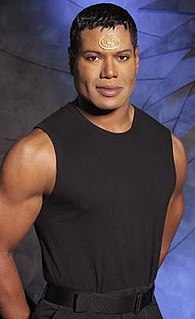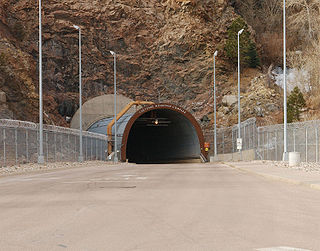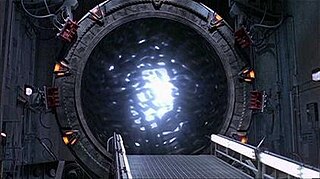Stargate SG-1 is a Canadian-American military science fiction adventure television series and part of Metro-Goldwyn-Mayer's Stargate franchise. The show, created by Brad Wright and Jonathan Glassner, is based on the 1994 science fiction film Stargate by Dean Devlin and Roland Emmerich. The television series was filmed in and around the city of Vancouver, British Columbia, Canada. The series premiered on Showtime on July 27, 1997 and moved to the Sci Fi Channel on June 7, 2002; the final episode first aired on Sky1 on March 13, 2007.

CMSgtTeal'c of Chulak is a fictional character in the military science fiction television series Stargate SG-1. Portrayed by Christopher Judge, Teal'c is a Jaffa warrior from the planet Chulak. As a Jaffa, Teal'c is a genetically modified human with an abdominal pouch that serves as an incubator for a larval Goa'uld. The larval symbiote grants enhanced strength, health, healing, and longevity; Teal'c is around 100 years old during the show's run and ages an additional 50 years in the final SG-1 episode. Teal'c's most notable feature is a golden tattoo found on his forehead, a sign that he once served the System Lord Apophis as First Prime, the most senior Jaffa rank.

The Goa'uld are a symbiotic race of ancient aliens from the American-Canadian military science fiction television franchise Stargate. The Goa'uld are parasites from the planet P3X-888, integrated within a host. The resulting creatures are a powerful race bent on galactic conquest and domination, largely without pity, compassion, or remorse. In the first eight seasons of Stargate SG-1, they are the greatest extraterrestrial threat to Earth known to the Stargate Command (SGC). The Goa'uld are the main enemies of SG-1 for most of the show, until they are replaced in this capacity by the Ori in seasons 9 and 10. They also appear in the Stargate Atlantis episode "Critical Mass", and in the DVD movie Stargate: Continuum. They are pejoratively called "snakes" or "snakeheads" by Jack O'Neill.

The Stargate Program is a fictional special access program that plays a key role in the Stargate franchise: it surrounds the operations of the Stargate on Earth. The core of the Stargate Program is Stargate Command (SGC), based at the Cheyenne Mountain Air Force Station near Colorado Springs, Colorado. During the run of Stargate SG-1, the NID is most critical of the Stargate Program, while the program is extended through the establishment of the Office of Homeworld Security/Homeworld Command and the International Oversight Advisory (IOA). The Atlantis Project as seen in Stargate Atlantis is part of the Stargate Program but works independently during season 1 of the show.
"Children of the Gods " is the first episode of the military science fiction television series Stargate SG-1. It was written by producers Jonathan Glassner and Brad Wright. The pilot was directed by Mario Azzopardi.
"Lost City" is the two-part finale to the seventh season of the science fiction television show Stargate SG-1. It was originally intended to be a second Stargate film, and was then to be the show's absolute finale, and finally ended up being the seventh season finale after the series was renewed. "Lost City" served as an introduction to Stargate Atlantis and the events portrayed were followed up in the Atlantis premiere "Rising" as well as in SG-1's own "New Order". "Lost City" also featured special guest star Chief of Staff of the Air Force John P. Jumper as himself. This episode was nominated for an Emmy Award in the category Outstanding Special Visual Effects for a Series and for a Gemini Award in the category Best Visual Effects.

In the fictional universe of Stargate, a number of technologically advanced races and societies have produced a variety of highly advanced weapons, tools, and spacecraft. By liaising with these races and learning from them, Earth too has begun to create its own futuristic technology. All such technology is SCI-classified top secret, and is used mainly by the SGC, its SG teams, or in Atlantis.
In the fictional universe of the Stargate franchise, the people of Earth have encountered numerous extraterrestrial races on their travels through the Stargate. In addition to a diversity of alien life, there is also an abundance of other humans, scattered across the cosmos by advanced aliens in the distant past. Some of the most significant species in Stargate SG-1 are the Goa'uld, the Asgard, and the Replicators. Stargate Atlantis, set in the Pegasus galaxy, introduced the Wraith and the Asurans. One of the most influential species in Stargate, the Ancients, have moved on to a higher plane of existence. For practical reasons of television productions, almost all of the alien and human cultures in the Stargate's fictional universe speak native English. Because of the time constraints of an hour-long episode, it would become a major hindrance to the story each week if the team had to spend a sizeable part of each episode learning to communicate with a new species.
"Reckoning" is a two-part episode from Season 8 of the science fiction television series Stargate SG-1. It resolves the long-running story arcs of the Goa'uld, the Replicators, and the Jaffa Rebellion, and are regarded as two of the most popular episodes of the series. This episode was nominated for an Emmy Award in the category "Outstanding Special Visual Effects for a Series" and a Leo Award in the category "Best Visual Effects".)
"Moebius" is the two-part season finale for season eight of the Canadian-American military science fiction television series Stargate SG-1. The episodes were written by Joseph Mallozzi, Paul Mullie, Executive producers Brad Wright and Robert C. Cooper, the episodes were directed by Peter DeLuise. The episodes were the strongest episodes in the eighth season on the Nielsen household ratings with fellow Stargate SG-1 episode "New Order". The episode got strong reviews from major media publishers worldwide.
"New Order" is the two-part Season 8 premiere of the science-fiction series Stargate SG-1. The episode earned a 2.4 Nielsen rating, a new record high for the show during its run on cable, which has since been tied, but never beaten. It also became the most-watched regular series episode ever for the Sci Fi Channel and the highest rated episode in the history of Stargate SG-1, drawing 3.22 million viewers. Part 2 was nominated for a Gemini Award in the category "Best Visual Effects".)
The two-part episode "Redemption" is the Season 6 premiere of the science fiction television series Stargate SG-1. Airing on June 7 and June 14, 2002, it was the first all-new SG-1 episode to be broadcast by SCI FI, the new home of SG-1 after the series' move from Showtime. The episode was written by producer Robert C. Cooper, and directed by Martin Wood. "Redemption" is the first episode where actor Corin Nemec had main cast status, his character Jonas Quinn replacing Daniel Jackson who died at the end of season 5. The episode also marks the second appearance of David Hewlett's character Rodney McKay, who later became a main character on Stargate Atlantis. "Redemption Part 2" was nominated for a Gemini Award in the category "Best Visual Effects".
"Threads" is an episode from Season 8 of the science fiction television series Stargate SG-1. Amanda Tapping won a Leo Award in the category "Dramatic Series: Best Lead Performance - Female" and Michael Shanks was nominated for a Leo Award in the category "Dramatic Series: Best Lead Performance - Male" for this episode.
"Full Circle" is the season finale for season six of the Canadian-American military science fiction television series Stargate SG-1. It was originally intended to be the last episode of Stargate SG-1.The episode was written by executive producer Robert C. Cooper and directed by Martin Wood. The episodes received an average Nielsen household rating and a low syndication rating compared to other season six episodes. The episode got strong reviews from major media publishers worldwide.
"Revelations" is the Season 5 finale episode of the science fiction television series Stargate SG-1. This episode was nominated for an Emmy in the category "Outstanding Special Visual Effects for a Series", and won a Gemini Award in the category "Best Visual Effects".
"Exodus" is the Season 4 finale episode of the science fiction television series Stargate SG-1. This episode was nominated for an Emmy in the category "Outstanding Special Visual Effects for a Series".

Stargate Worlds was to be a massively multiplayer online role-playing game (MMORPG) video game, but it was put on hold and never released. It was developed by Cheyenne Mountain Entertainment (CME) in association with Metro-Goldwyn-Mayer (MGM) and would have been published by FireSky for Microsoft Windows. The game's setting was based on the military science fiction series Stargate SG-1. The game was to focus on a premise set around an ancient device called the "Stargate".

Stargate: Resistance was an online third-person shooter owned and operated by American studio Dark Comet Games, powered by the Unreal 3 engine, and based on the television series Stargate SG-1. It was originally released in 2010 by Firesky and Cheyenne Mountain Entertainment, however Cheyenne Mountain Entertainment went into receivership in March 2010 and Firesky entered into an agreement with Dark Comet Games for the maintenance, operation and development of Stargate Resistance. The game used a "buy to play" business model, with a one-off purchase fee and no monthly subscription fee. The game servers were shut down on January 15, 2011. A fan powered central server solution has been put in place, making the game once again playable.








